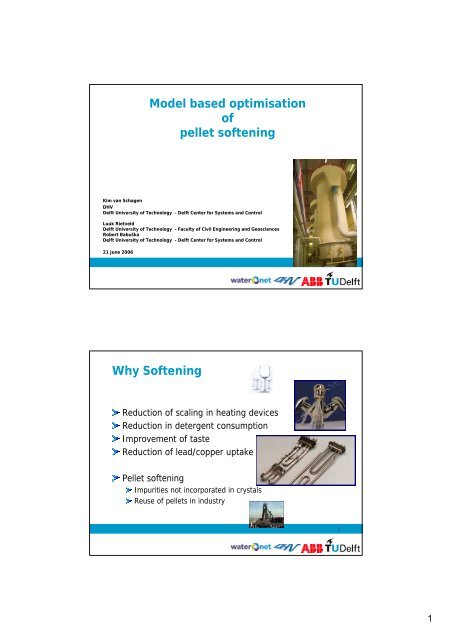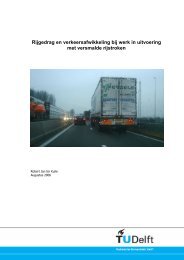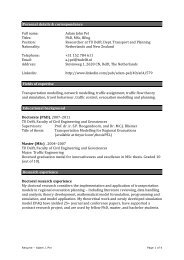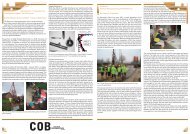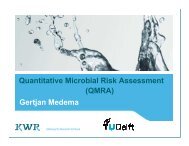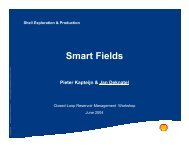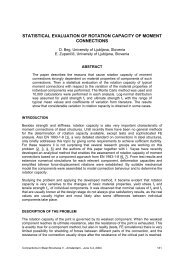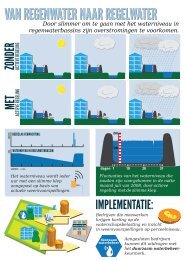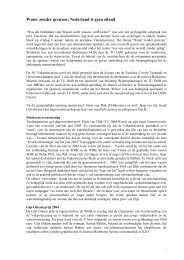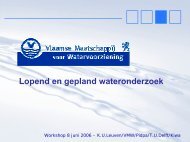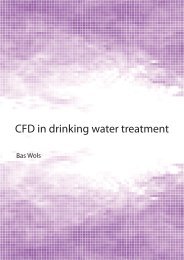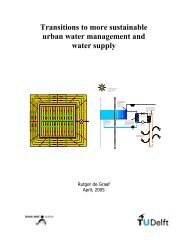Model based optimisation of pellet softening Why Softening - TU Delft
Model based optimisation of pellet softening Why Softening - TU Delft
Model based optimisation of pellet softening Why Softening - TU Delft
Create successful ePaper yourself
Turn your PDF publications into a flip-book with our unique Google optimized e-Paper software.
Fluctuation in Water Quality5<strong>Model</strong> <strong>based</strong> <strong>optimisation</strong><strong>Model</strong> calcium carbonic acid equilibrium<strong>Model</strong> fluidised bed reactor<strong>Model</strong> crystallisation velocityCalibrate crystallisation velocityValidate model (2x)Optimise <strong>pellet</strong> sizeConclusions63
<strong>Model</strong>ling the reactorCylinder-shaped columnm 3 /sEffluentF wFluidized bedgrain suplyi+1ii-1m g,i+1 m c,i+1 p i+1 dx i+1m g,im c,i p i dx im g,i-1 m c,i-1 p i+1 dx i-1v pNaOHWater<strong>pellet</strong>dischargeKg grain/s9<strong>Model</strong>ling the reactorMass <strong>of</strong> calcium carbonate /Mass <strong>of</strong> grainsPellet diameter & Pellet densityTemperaturePellet settling velocityRichardson and Zaki Expansion formulaporosityBed heightSpecific surface105
CalibrationUsing identified bed40 combinations <strong>of</strong> water flow and caustic soda dosageRepeated 3 times in 3 dayspH <strong>of</strong>fsetk T and D f found15Validation Full scaleWeesperkarspel (Amsterdam)8 reactorsTemperature variation 4 - 27 °CFlow variations reactor 60-100 m/h1 week <strong>of</strong> data in February 2004 and one week in June 2003Bed composition estimateCaustic soda flow measurement correction168
Validation Full scaleKatwijk- fluidised bedConstant water flow in the reactorTemperature variation 9 - 16 °CInfluent Calcium and Bicarbonate variations8 typical situationsSieve analysis at 6-8 heights in the bedCloggedLarge <strong>pellet</strong>s17Validation Full scaleKatwijk- crystallisation5 identified bedsEffective caustic soda dosage with measured Natriumconcentration showed measurement error <strong>of</strong> 4-12%Relatively high influentpH and HCO 3-189
Process <strong>optimisation</strong>ReactorPellet size control in the reactorLimited focus in current operationConstant <strong>pellet</strong> size and maximal bed height19Process <strong>optimisation</strong>Reactor –pH pr<strong>of</strong>ile2010
ConclusionsS<strong>of</strong>tening process <strong>optimisation</strong> through modellingIdentifying unmeasured process stateDetection <strong>of</strong> malfunctioning measurementsAnalysis <strong>of</strong> laboratory dataSignalling undesired process conditions<strong>Model</strong> <strong>based</strong> <strong>optimisation</strong>Trade-<strong>of</strong>f between water quality and garnet sand use21Questions?2211


